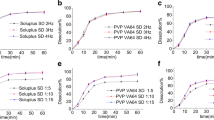Abstract
Solvent and melt techniques were used to obtain molecular dispersion of the poorly soluble spironolactone (SPIR) model drug enhancing its dissolution rate. DSC study of the interaction between SPIR and hydroxypropyl-β-cyclodextrin confirmed the need for molecular dispersion if their complexation is required. Solvent-free twin-screw extrusion was suitable for forming inclusion complex significantly below the melting temperature of the SPIR. According to DSC, Raman and XRPD results fine dispersion of both components was achieved in a hydrophilic polymer. The molecules of the active ingredient are separated from each other in the polymer and the lack of the lattice energy causes faster dissolution.










Similar content being viewed by others
References
Hörter D, Dressman JB. Influence of physicochemical properties on dissolution of drugs in the gastrointestinal tract. Adv Drug Deliv Rev. 2001;46:75–87.
Lian Yu. Amorphous pharmaceutical solids: preparation, characterization and stabilization. Adv Drug Deliv Rev. 2001;48:27–42.
Craig DQM, Royall PG, Kett VL, Hopton ML. The relevance of the amorphous state to pharmaceutical dosage forms: glassy drugs and freeze dried systems. Int J Pharm. 1999;179:179–207.
Leuner C, Dressman J. Improving drug solubility for oral delivery using solid dispersions. Eur J Pharm Biopharm. 2000;50:47–60.
Vasconcelos T, Sarmento B, Costa P. Solid dispersions as strategy to improve oral bioavailability of poor water soluble drugs. Drug Discov Today. 2007;12:1068–75.
Uekama K, Hirayama F, Irie T. Cyclodextrin drug carrier systems. Chem Rev 1998;98:2045–76.
Veiga MD, Merino M, Fernández D, Lozano R. Characterization of some cyclodextrin derivatives by thermal analysis. J Therm Anal Calorim. 2002;68:511–6.
Laitinen R, Suihko E, Toukola K, Björkqvist M, Riikonen J, Lehto VP, Järvinen K, Ketolainen J. Intraorally fast-dissolving particles of a poorly soluble drug: preparation and in vitro characterization. Eur J Pharm Biopharm. 2009;71:271–81.
Fukuda M, Miller DA, Peppas NiA, McGinity JW. Influence of sulfobutyl ether-cyclodextrin (Captisol®) on the dissolution properties of a poorly soluble drug from extrudates prepared by hot-melt extrusion. Int J Pharm. 2008;350:88–196.
Six K, Leuner Ch, Dressman J, Verreck G, Peeters J, Blaton N, Augustijns P, Kinget R, Van den Mooter G. Thermal properties of hot-stage extrudates of itraconazole and EUDRAGIT E100. J Therm Anal Calorim. 2002;68:591–601.
Bartsch SE, Griesser UJ. Physicochemical properties of the binary system glibenclamide and polyethylene glycol 4000. J Therm Anal Calorim. 2004;77:555–69.
Berbenni V, Marini A, Bruni G, Maggioni A, Riccardi R, Orlandi A. Physico-chemical characterisation of different solid forms of spironolactone. Thermochim Acta. 1999;340–341:117–29.
Marini A, Berbenni V, Bruni G, Maggioni A, Orlandi A, Villa M. Thermodynamics of complex melting process: the case of spironolactone. Thermochim Acta. 2001;374:171–84.
Giordano F, Novak C, Moyano JR. Thermal analysis of cyclodextrins and their inclusion compounds. Thermochim Acta. 2001;380:123–51.
de Araujo DR, Tsuneda SS, Cereda CMS, Del GF Carvalho F, Preté PSC, Fernandes SA, Yokaichiya F, Franco MKKD, Mazzaro I, Fraceto LF, de FA Braga A, de Paula E (2008) Development and pharmacological evaluation of ropivacaine-2-hydroxypropyl-β-cyclodextrin inclusion complex. Eur J Pharm Sci 33:60–71.
Aki H, Niiya T, Iwase Y, Yamamoto M. Calorimetry to evaluate inclusion mechanism in the complexation between 2-hydroxypropyl-β-cyclodextrin and barbiturates in aqueous solution. J Therm Anal Calorim. 2001;64:713–9.
Brown ME, Glass BD, Worthington MS. Binary systems of nifedipine and various cyclodextrins in the solid state. J Therm Anal Calorim. 2002;68:631–46.
Soliman OAE, Kimura K, Hirayama F, Uekama K, El-Sabbagh HM, Abd El-Gawad Abd El-Gawad H, Hashim FM. Amorphous spironolactone-hydroxypropylated cyclodextrin complexes with superior dissolution and oral bioavailability. Int J Pharm. 1997;149:73–83.
Rajabi O, Tayyari F, Salari R, Tayyari SF. Study of interaction of spironolactone with hydroxypropyl-b-cyclodextrin in aqueous solution and in solid state. J Mol Struct. 2008;878:78–83.
Morin N, Chilouet A, Millet J, Rouland J-C. Bifonazole-β-cyclodextrin inclusion complexes. J Therm Anal Calorim. 2000;62:187–201.
Caira MR, Dodds DR, Nassimbeni LR. Polymorphism and cyclodextrin inclusion of salbutamol laurate. J Therm Anal Calorim. 2002;68:647–55.
Beatrice Nicolaï, Espeau p, Céolin R, Perrin M-A, Zaskel L, Giovannini J, Leveiller F. Polymorph formation from solvate desolvation. J Therm Anal Calorim. 2007;90(2):337–9.
Author information
Authors and Affiliations
Corresponding author
Rights and permissions
About this article
Cite this article
Patyi, G., Bódis, A., Antal, I. et al. Thermal and spectroscopic analysis of inclusion complex of spironolactone prepared by evaporation and hot melt methods. J Therm Anal Calorim 102, 349–355 (2010). https://doi.org/10.1007/s10973-010-0936-0
Received:
Accepted:
Published:
Issue Date:
DOI: https://doi.org/10.1007/s10973-010-0936-0




